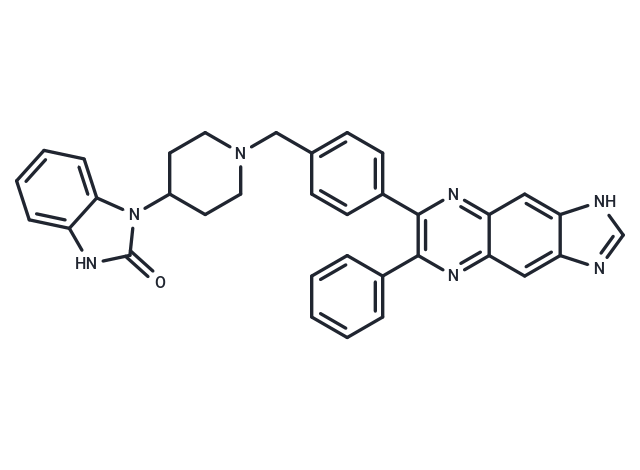Shopping Cart
- Remove All
 Your shopping cart is currently empty
Your shopping cart is currently empty

AKT inhibitor VIII (AKTi-1/2) is a highly specific inhibitor of Akt1/2, with IC50 values of 58 nM and 210 nM respectively, demonstrating approximately 36-fold greater selectivity for Akt1 over Akt3.

| Pack Size | Price | Availability | Quantity |
|---|---|---|---|
| 1 mg | $44 | In Stock | |
| 2 mg | $61 | In Stock | |
| 5 mg | $107 | In Stock | |
| 10 mg | $155 | In Stock | |
| 25 mg | $278 | In Stock | |
| 50 mg | $455 | In Stock | |
| 100 mg | $672 | In Stock | |
| 1 mL x 10 mM (in DMSO) | $129 | In Stock |
| Description | AKT inhibitor VIII (AKTi-1/2) is a highly specific inhibitor of Akt1/2, with IC50 values of 58 nM and 210 nM respectively, demonstrating approximately 36-fold greater selectivity for Akt1 over Akt3. |
| Targets&IC50 | Akt2:210 nM, Akt1:58 nM |
| In vitro | Akti-1/2 (50 mg/kg, i.p.) inhibits both basal and IGF-stimulated Akt1/2 phosphorylation in the lungs of mice. |
| In vivo | In cell-based IPKA (C33A) assays, AKT inhibitor VIII suppresses Akt1/2 with IC50 values of 305 and 2086 nM, respectively. It significantly increases caspase-3 activity, inducing apoptosis in MCF7, HT29, and A2780 cells. In hepatocytes, it inhibits insulin's regulation of PEPCK and the expression of G6Pase and FOXO1 activity. Additionally, AKT inhibitor VIII enhances PAR-1-mediated platelet aggregation by blocking PKB. It inhibits cell growth in HCC827, NCI-H522, NCI-1651, and PC-9 cells with IC50 values of 4.7, 7.25, and 9.5 μM, respectively. When combined with gefitinib, the effects of suppressing cell growth and inducing apoptosis are enhanced. |
| Kinase Assay | Kinase screen: Briefly, all assays (25.5 μl at 21°C for 30 min) are performed using a Biomek 2000 Laboratory Automation Workstation in a 96-well format. Reactions contains 5–20 mU purified kinase along with substrate peptide or protein and are initiated by the addition of 10 mM MgAcetate and 5, 20, or 50 μM ATP ([γ-33P]-ATP, 800 cpm/pmol). |
| Cell Research | The cell growth inhibitory effect of AKTi-1/2 is studied using the 96 h sulforhodamine B assay (SRB). Drug concentrations that inhibited 50% of cell growth (IC50) are calculated for each compound in GraphPad Prism 6.0 using non-linear regression analysis and sigmoidal dose–response (variable slope) equation.(Only for Reference) |
| Alias | AKTi-1/2 |
| Molecular Weight | 551.64 |
| Formula | C34H29N7O |
| Cas No. | 612847-09-3 |
| Smiles | O=c1[nH]c2ccccc2n1C1CCN(Cc2ccc(cc2)-c2nc3cc4[nH]cnc4cc3nc2-c2ccccc2)CC1 |
| Relative Density. | 1.351g/cm3 |
| Storage | Powder: -20°C for 3 years | In solvent: -80°C for 1 year | Shipping with blue ice. | |||||||||||||||||||||||||
| Solubility Information | DMSO: 11 mg/mL (20 mM), Heating is recommended. | |||||||||||||||||||||||||
Solution Preparation Table | ||||||||||||||||||||||||||
DMSO
| ||||||||||||||||||||||||||

Copyright © 2015-2025 TargetMol Chemicals Inc. All Rights Reserved.